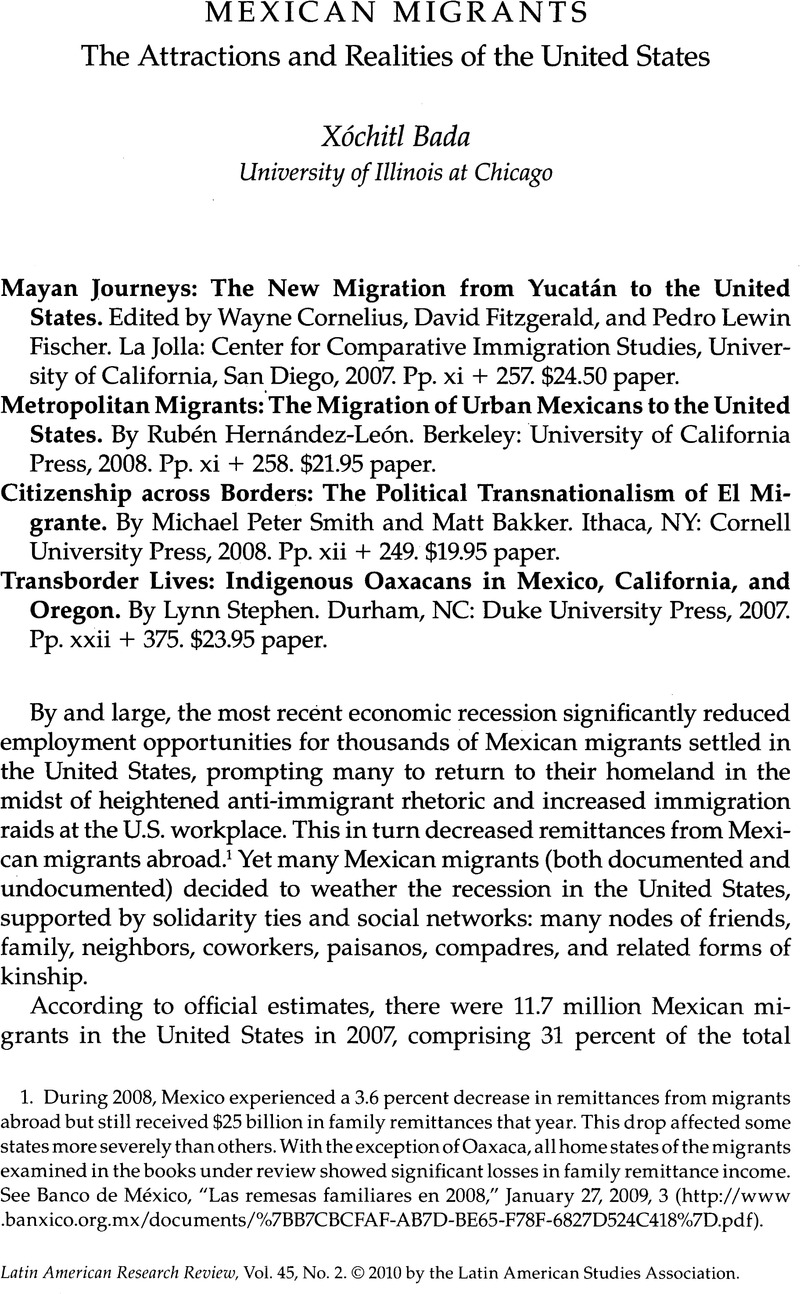No CrossRef data available.
Article contents
Mexican Migrants: The Attractions and Realities of the United States
Review products
Published online by Cambridge University Press: 05 September 2022
Abstract

- Type
- Review Essays
- Information
- Copyright
- Copyright © 2010 by the Latin American Studies Association
References
1. During 2008, Mexico experienced a 3.6 percent decrease in remittances from migrants abroad but still received $25 billion in family remittances that year. This drop affected some states more severely than others. With the exception of Oaxaca, all home states of the migrants examined in the books under review showed significant losses in family remittance income. See Banco de México, “Las remesas familiares en 2008,” January 27, 2009, 3 (http://www.banxico.org.mx/documents/%7BB7CBCFAF-AB7D-BE65-F78F-6827D524C418%7D.pdf).
2. Jeffrey S. Passei, “Growing Share of Immigrants Choosing Naturalization,” Pew Hispanic Center Report, 2007, 18.
3. Liliana Rivera Sánchez and Fernando Lozano Ascencio, though focused on migration from the state of Morelos to the United States, recognize the importance of internal migration: “Los contextos de salida urbanos y rurales y la organización social de la migración,” Migración y Desarrollo 6 (2006): 45–78.
4. Unfortunately, Hernández-León's interviews with unionized factory workers in Houston do not address the impact that prior union socialization in Mexico, and the demise of union power and employment security in Monterrey, may have had on these migrant workers' engagement in U.S. labor unions.
5. See Douglas Massey, Jorge Durand, and Nolan J. Malone, Beyond Smoke and Mirrors (New York: Russell Sage Foundation, 2002).
6. For a comparison of smuggling fees in traditional and emerging sending regions, see Jezmin Fuentes, Henry L'Esperance, Raúl Pérez, and Caitlin White, “Impacts of U.S. Immigration Policies on Migrant Behavior,” in Impacts of Border Enforcement on Mexican Immigration, ed. Wayne A Cornelius and Jessa M. Lewis (La Jolla: Center for Comparative Immigration Studies, University of California, San Diego, 2007), 53–73.
7. For a more comprehensive theoretical and empirical analysis of self-identification, see Jonathan Fox, “Reframing Mexican Migration as a Multi-Ethnic process,” Latino Studies 4 (2006): 39–61; Jonathan Fox and Gaspar Rivera Salgado, eds., Indigenous Mexican Migrants in the United States (La Jolla: Center for U.S.-Mexican Studies, Center for Comparative Immigration Studies, University of California, San Diego, 2004). For a case study of ethnic identity among Nahua migrants, see Martha García, “Rituales de paso y categorías sociales en la migración internacional nahua del Alto Balsas, Guerrero,” Cuicuilco 15 (2008): 77–96.
8. On differences between mestizo and indigenous organizations, see Gaspar Rivera-Salgado and Luis Escala Rabadán, “Collective Identity and Organizational Strategies of Indigenous and Mestizo Mexican Migrants,” in Indigenous Mexican Migrants in the United States, ed. Jonathan Fox and Gaspar Rivera Salgado (La Jolla: Center for U.S.-Mexican Studies, Center for Comparative Immigration Studies, University of California, San Diego, 2004), 145–178. For an analysis of Mexican civic binationality in Latino immigrant mobilizations during the spring of 2006, see Jonathan Fox and Xóchitl Bada, “Migrant Civic Engagement,” in Rallying for Immigrant Rights, ed. Irene Bloemraad and Kim Voss (Berkeley: University of California Press, forthcoming), available at http://www.wilsoncenter.org/topics/docs/Fox_Bada_chapterfinall.pdf.
9. Arjun Appadurai, Modernity at Large: Cultural Dimensions of Globalization (Minneapolis: University of Minnesota Press, 1996), 33–34; Samuel P. Huntington, “The Hispanic Challenge,” Foreign Policy 141 (March-April 2004): 30–45.
10. For a comparative analysis of the 3 × 1 Program in the context of Michoacán migrants in Chicago, see Xóchitl Bada, “Sociopolitical Remittances, Rural Development, and Mexican Migrant Hometown Associations: The Shifting Nature of Transnational and Trans-Local Connections in The Chicago-Michoacán Corridor,” Ph.D. diss., University of Notre Dame, 2008, 110–220.
11. Arturo Escobar, “Actores, redes e novos produtores de conhecimento: Os movimentos sociais e a transição paradigmática nas ciências,” in Conhecimiento prudente para uma vida decente, ed. Boaventura de Sousa Santos (Porto: Afrontamento, 2003), 605–630, qtd. in Stephen, Transborder Lives, 19.




